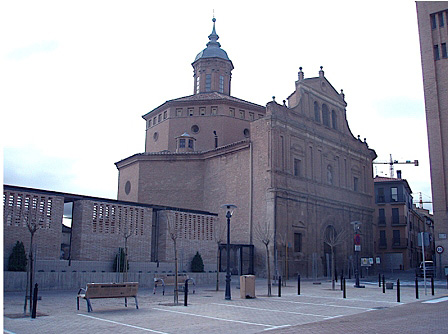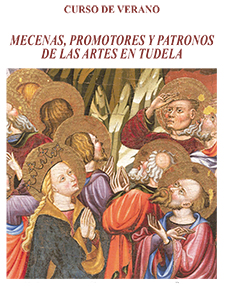PATRONS, PROMOTERS AND PATRONS OF THE ARTS IN TUDELA
28 August 2014
Monarchy, Patrons and Sisters in the Society of Mary
D. Ricardo Fernández Gracia. Chair of Heritage and Art of Navarre.
Among the most progressive works belonging to the chapter of the architectural renovation of the eighteenth century in Navarre, the church of high school of the Company of Mary of Tudela stands out, built in two phases, the first between 1732 and 1742 and the second from 1756. Its construction coincided with the stay in the capital of La Ribera of the renowned architect, Friar José Alberto Pina, Carmelite footwear and author of numerous churches in Aragón, the Bishop's palace in Albarracín and who would later achieve deserved fame in Valencia, where he made position of other important churches in Játiva and designed models for the Pious Schools of Valencia, which earned him the unanimous award in 1769 of degree scroll as a member of the Academy of San Carlos. This friar must undoubtedly be the author of the project or at least the one who adapted the outline of the Company of Mary to the case of Tudela. The second phase with the construction of the lower and upper choir and the pantheon was carried out between 1756 and 1761, indicating that everything would be done from agreement with the existing plan from years before.
The church -conventual and collegiate at the same time- is one of the most exceptional examples of all Baroque architecture in Navarre. Its plan, in harmony with the needs of the order of the Company of Mary, presents a large octagonal body surrounded in part by ambulatories interrupted by two low choirs and two other bodies added at the foot, above the last of which rises the choir loft; thus coexisting centrality and longitudinality with evident echoes of Roman and Venetian architecture. Its relationship with works of that origin and with the basilica of Loyola has already been made clear, but we cannot forget the regulations on "The elements of layout" in the houses of the Company of Mary printed in 1638. They recommend a square floor plan and the construction of two low choirs or tribunes - one for nuns and novices and the other for educating them - plus a high one at the foot in the cloister. Such a plan obeys the function of high school where apostolate, teaching and contemplation are combined.
The material execution of the building in the first phase may have been entrusted to José Marzal y Gil, the best master of Tudela at the time, who contracted the works of the second phase from 1756. The brothers Antonio and José del Río, masters without skill in those central decades of the 18th century in Tudela, were in charge of the rich set of plasterwork, altarpieces and tribunes. The general plan of this church was copied in other schools such as Zaragoza (1744), Mexico (1754), Santiago de Compostela (1759), San Fernando (1760) and Vergara (1799), foundations from the house of Tudela in the Age of Enlightenment.

Church of the Company of Mary
Exterior

Church of the Company of Mary
Interior
The inauguration of the building was reflected in the following text, written, most certainly by Mother Croy, daughter of the viceroy of Navarre: On April 6, 1742, Saturday, which was that day, at four o'clock in the afternoon, the Blessed Sacrament was transferred from the old church to the newly built one. All the principals of the town were present with axes. Before blessing the church with the formalities of the Ritual Don Félix Agustín de Aperregui, dignity treasurer of the Insigne Colegial, assisted by the chapter of San Juan. The procession was made solemnly through the Plazuela with the music of Santa Maria, ringing of bells of the house, parish and convent of Santo Domingo and then there were many fires, lanterns and bonfires. The next day came in procession the Very Illustrious Cabildo and Dean with the city to celebrate the day and feast, with the Lord patent. Preached the Most Reverend Father Vicente Hurtado de Mendoza, President high school of the Society of Jesus. The next day another function was held with attendance of the same, Señor Manifesto and sermon was preached by the Most Reverend Father Lucas Lacunza of the Society of Jesus. The following day, the funeral and transfer of the bones of our very special benefactor Don Francisco Garcés were celebrated, which were taken from the old church to the new one in procession through the chapter of San Juan". Music, sacred oratory, bells and, in general, the invariable and traditional elements of the celebration are repeated as on other occasions.
Alms from the Indies, requested by the prioress to the Patriarch of the Indies and to the same committee of the Indies, must have been decisive in the financing of this church, as well as the contributions of different nuns who came from different parts of Spain to swell the project of innovation in education, many of them from wealthy and noble families. In any case it is convenient to contextualize this project so much with what Caro Baroja denominated as the Navarrese Hour, in which the Navarrese negotiated skillfully their status and their taxes. The same Felipe V, in 1719 granted annual pension of 1,000 ducats on the rents of the archbishopric of Toledo to the high school tudelano.
In the Tudela of those times the chapel of the Holy Spirit in the cathedral (1733-1744), the convent and church of Capuchinas (1749-1753 and 1753-1755), the palace of the marquises of Huarte (1740-1744), the throne of Santa Ana (1737-1751) and the altarpieces of the church of the Jesuits (1748) were being built.
An aspect that has hardly been noticed and that must be taken into account in the realization of this ensemble and its church, is the context within the walls of the house, with a group of nuns led by three great women, intelligent, attractive staff in the attention and skilled in everything, Mothers Croy, Aperregui and Colmenares. The first of them was the daughter of the former viceroy of Navarre, Prince Chimaz (†1686). She entered in 1703 and died in 1767, after having exercised different offices and that of prioress between 1725 and 1734 and from 1737. In 1744 she went to the foundation of Zaragoza and after ten years returned to Tudela. Petronila de Aperregui (1710-1790) belonged to the most florid of the nobility of Tudela, her family owned the board of trustees of the Chapel of the Virgen de los Remedios, in San Nicolás and was a foundress in San Fernando where she died and left a great literary bequest . Mother Nicolasa Colmenares (1711-1788) was a native of Pamplona and sister of the lawyer, oidor and poet José Ignacio Colmenares y Aramburu. The chronicles always refer to her as a nun of "superior talent". Her example put an end to the vocational shortage and Tudela became the seed of the houses leaving Tudela. The foundress of Mexico, Mother Azlor had great interest in taking her to the foundation of Mexico, in 1752, but the prelate and community civil service examination and even a resource to the nuncio who ordered her not to leave under penalty of major excommunication, so it was her niece, Mother Maria Josefa Sartolo y Colmenares. Instead she left for the foundation of Compostela in 1759. To these three religious it is necessary to add a long list of many others whose prosopographical study has to give the definitive lights to understand the reality of high school in its different aspects, since many of them were related to illustrious Jesuits, they belonged to the nobility or to the emergent social groups and protagonists of the Navarrese Hora of the XVIII century.
PROGRAM
Tuesday, 26th August
Three exceptional altarpieces for three promoters
Ms. Mercedes Jover Hernando. Museum of Navarre
The great patrons of the Renaissance, a mirror of humanism
María Concepción García Gainza. Chair of Navarrese Heritage and Art
Wednesday, 27th August
Around the patron saints
D. Ricardo Fernández Gracia
Chair of Navarrese Heritage and Art
Patrons and patrons of Tudela silverware
D. Ignacio Miguéliz Valcarlos
UNED Pamplona
Patrons and Patronages in the Collegiate ( visit guidada)
Ms. María Josefa Tarifa Castilla. University of Zaragoza
Thursday, 28th August
Town planning and civil architecture
D. Carlos Carrasco Navarro. Doctor in History of Art
The great men of the Enlightenment
D. Pablo Guijarro Salvador. Chair of Navarrese Heritage and Art.
Monarchy, patrons and nuns in the Company of Mary ( visit guided)
D. Ricardo Fernández Gracia
Chair of Navarrese Heritage and Art

